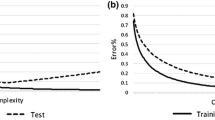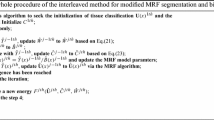Abstract
Manual segmentation of Magnetic Resonance Images (MRI) is a time-consuming process, thus automatic segmentation of brain MR images has attracted more attention in recent years. In this paper, we introduce Dynamic Classifier Selection Markov Random Field (DCSMRF) algorithm for supervised segmentation of brain MR images into three main tissues such as White Matter (WM), Gray Matter (GM) and Cerebrospinal Fluid (CSF). DCSMRF combines a novel ensemble method with the Markov Random Field (MRF) algorithm and tries to obtain the advantages of both algorithms. For the ensemble part of DCSMRF, we propose an ensemble method called Dynamic Classifier System-Weighted Local Accuracy (DCS-WLA) which is a type of Combination of Multiple Classifier (CMC) algorithm. Later, the MRF algorithm is utilized for incorporating spatial, contextual and textural information in this paper. For the MRF section, an energy function based on the output of the DCS-WLA algorithm is proposed, then maximum value for Maximum A Posterior (MAP) criterion is searched to obtain optimal segmentation. The MRF algorithm applies similar to a post processing step in which only a subset of pixels is selected for optimization step. Hence, a vast amount of search space is pruned. Consequently, the computational burden of the proposed algorithm is more tolerable than the conventional MRF-based methods. Moreover, by employing ensemble algorithms, the accuracy and reliability of final results are enhanced compared to the individual methods.






Similar content being viewed by others
References
Ahmadvand A, Daliri MR (2014) Brain MR image segmentation methods and applications. OMICS J Radiol (4):3, e130
Ahmadvand A, Daliri MR (2015) Improving the runtime of MRF based method for MRI brain segmentation. Appl Math Comput 256:808–818
Ahmadvand A, Kabiri P (2014) Multispectral MRI image segmentation using Markov random field model. SIViP:1–8
Ahmadvand A, Sharififar M, Daliri MR (2015) Supervised segmentation of MRI brain images using combination of multiple classifiers. Australas Phys Eng Sci Med 38(2):241–253
Ahmadvand A et al (2015) A novel CMC based method for MR! brain image segmentation. In 2015 2nd international conference on Knowledge-Based Engineering and Innovation (KBEI). IEEE
Bae MH et al (2009) Automated segmentation of mouse brain images using extended MRF. NeuroImage 46(3):717–725
Bae MH, Wu T, Pan R (2010) Mix-ratio sampling: classifying multiclass imbalanced mouse brain images using support vector machine. Expert Syst Appl 37(7):4955–4965
Balafar M (2012) Gaussian mixture model based segmentation methods for brain MRI images. Artif Intell Rev:1–11
Besag J (1975) Statistical analysis of non-lattice data. Journal of the Royal Statistical Society, Series D (The Statistician) 24(3):179–195
Caldairou B et al (2011) A non-local fuzzy segmentation method: application to brain MRI. Pattern Recogn 44(9):1916–1927
Dubes R et al (1990) MRF model-based algorithms for image segmentation. In Pattern recognition, 1990. Proceedings., 10th international conference on. IEEE
Geman S, Geman D (1984) Stochastic relaxation, Gibbs distributions, and the Bayesian restoration of images. Pattern Anal Mach Intell IEEE Trans 3(6):721–741
Greenspan H, Ruf A, Goldberger J (2006) Constrained Gaussian mixture model framework for automatic segmentation of MR brain images. Med Imaging IEEE Trans 25(9):1233–1245
Hammersley JM, Clifford P (1971) Markov fields on finite graphs and lattices, (unpublished)
Hashemi RH, Bradley WG, Lisanti CJ (2012) MRI: the basics. Wolters Kluwer Health, Philadelphia
Jiménez-Alaniz JR, Medina-Bañuelos V, Yáñez-Suárez O (2006) Data-driven brain MRI segmentation supported on edge confidence and a priori tissue information. Med Imaging IEEE Trans 25(1):74–83
Kim W, Lee KM (2011) A hybrid approach for MRF optimization problems: combination of stochastic sampling and deterministic algorithms. Comput Vis Image Underst 115(12):1623–1637
Liu Y-T, Zhang H-X, Li P-H (2011) Research on SVM-based MRI image segmentation. J China Univ Posts Telecommun 18:129–132
Marroquín JL et al (2002) An accurate and efficient Bayesian method for automatic segmentation of brain MRI. Med Imaging IEEE Trans 21(8):934–945
Mayer A, Greenspan H (2009) An adaptive mean-shift framework for MRI brain segmentation. Med Imaging IEEE Trans 28(8):1238–1250
Ortiz A et al (2011) MRI brain image segmentation with supervised SOM and probability-based clustering method. In New challenges on bioinspired applications. Springer. p 49–58
Ortiz A et al (2012) Unsupervised neural techniques applied to MR brain image segmentation. AdvArtif Neural Syst 2012:1
Ortiz A et al (2013) Improving MRI segmentation with probabilistic GHSOM and multiobjective optimization. Neurocomputing 114:118–131
Ouadfel S, Batouche M (2003) MRF-based image segmentation using ant colony system. Electron Lett Comput Vision Image Anal 2(2):12–24
Pham D et al (1997) An automated technique for statistical characterization of brain tissues in magnetic resonance imaging. Int J Pattern Recognit Artif Intell 11(08):1189–1211
Platt J (1999) Probabilistic outputs for support vector machines and comparisons to regularized likelihood methods. Adv Large Margin Classif 10(3):61–74
Prakash RM, Kumari RSS (2016) Gaussian mixture model with the inclusion of spatial factor and pixel re-labelling: application to MR brain image segmentation. Arab J Sci Eng:1–11
Qian H, Wu X, Xu Y (2011) Dynamic analysis of crowd behavior. In Intelligent surveillance systems. Springer. p 119–154
Rajapakse JC, Giedd JN, Rapoport JL (1997) Statistical approach to segmentation of single-channel cerebral MR images. Med Imaging IEEE Trans 16(2):176–186
Rivest-Hénault D, Cheriet M (2011) Unsupervised MRI segmentation of brain tissues using a local linear model and level set. Magn Reson Imaging 29(2):243–259
da Silva Ferreira AR (2007) A Dirichlet process mixture model for brain MRI tissue classification. Med Image Anal 11(2):169–182
Siyal MY, Yu L (2005) An intelligent modified fuzzy c-means based algorithm for bias estimation and segmentation of brain MRI. Pattern Recogn Lett 26(13):2052–2062
Tohka J et al (2005) Genetic algorithms for finite mixture model based tissue classification in brain MRI. In Proc. of European medical and biological engineering conference, IFMBE proceedings
Tohka J et al (2007) Genetic algorithms for finite mixture model based voxel classification in neuroimaging. Med Imaging IEEE Trans 26(5):696–711
Vaidyanathan M et al (1995) Comparison of supervised MRI segmentation methods for tumor volume determination during therapy. Magn Reson Imaging 13(5):719–728
Wolpert DH, Macready WG (1997) No free lunch theorems for optimization. IEEE Trans Evol Comput 1:67–82
Woods K, Bowyer K, Kegelmeyer WP Jr (1996) Combination of multiple classifiers using local accuracy estimates. In Computer vision and pattern recognition, 1996. Proceedings CVPR'96, 1996 I.E. computer society conference on. IEEE
Worth AJ (1996)The Internet brain segmentation repository (IBSR), http://www.cma.mgh.Harvard.edu/ibsr
Wu T et al (2012) A prior feature SVM-MRF based method for mouse brain segmentation. NeuroImage 59(3):2298–2306
Yousefi S, Azmi R, Zahedi M (2012) Brain tissue segmentation in MR images based on a hybrid of MRF and social algorithms. Med Image Anal 16(4):840–848
Zhang Y, Brady M, Smith S (2001) Segmentation of brain MR images through a hidden Markov random field model and the expectation-maximization algorithm. Med Imaging IEEE Trans 20(1):45–57
Acknowledgements
The work has been supported by internal funding from IUST University. No external financial support has been obtained for this work.
Author information
Authors and Affiliations
Corresponding author
Ethics declarations
Conflict of Interest
The authors have no conflicts of interest to declare
Rights and permissions
About this article
Cite this article
Ahmadvand, A., Daliri, M.R. & Zahiri, S.M. Segmentation of brain MR images using a proper combination of DCS based method with MRF. Multimed Tools Appl 77, 8001–8018 (2018). https://doi.org/10.1007/s11042-017-4696-8
Received:
Revised:
Accepted:
Published:
Issue Date:
DOI: https://doi.org/10.1007/s11042-017-4696-8




